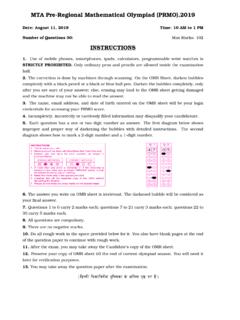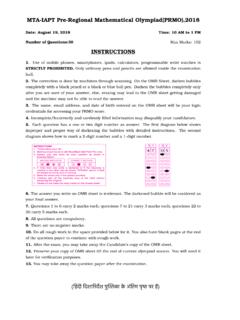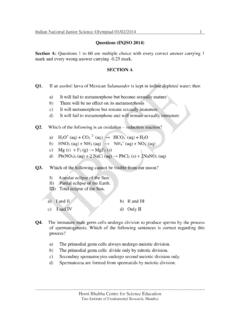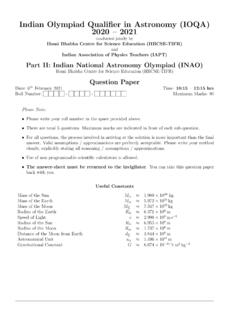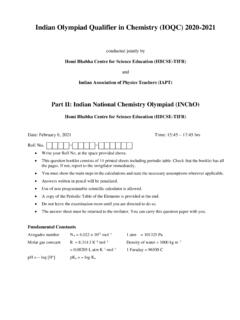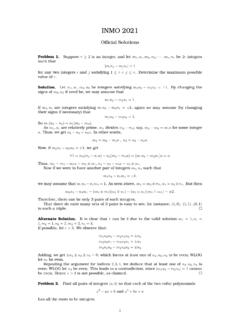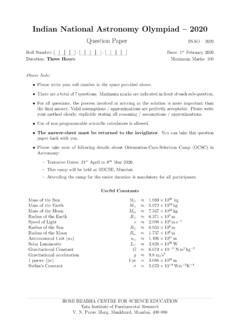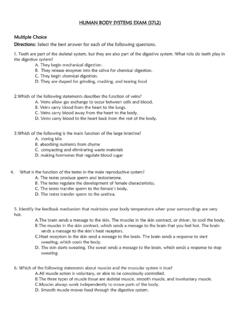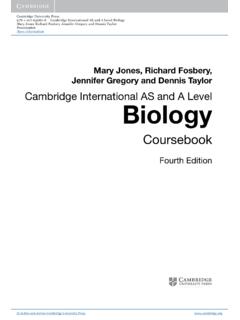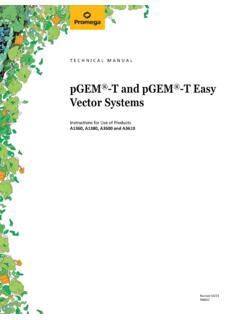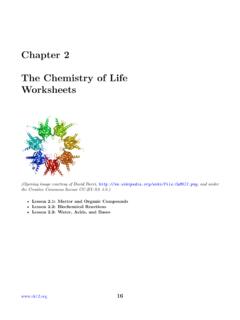Transcription of Indian Olympiad Qualifier in Biology (IOQB) 2020-2021
1 Indian Olympiad Qualifier in Biology (IOQB) 2020-2021 conducted jointly by Homi Bhabha Centre for Science Education (HBCSE-TIFR) and Indian Association of Physics Teachers (IAPT) Part II: Indian National Biology Olympiad (INBO) Homi Bhabha Centre for Science Education (HBCSE-TIFR) Date: February 7, 2021 Time: 15:45 17:45 hrs INSTRUCTIONS The question paper is divided into Sections A and B. All answers should be written in the answer booklet only which will be collected at the end of the examination. The question paper need not be submitted to the examiner. Before starting, ensure that you have received a copy of the question paper containing a total of 21 numbered pages. Section A Section A consists of 30 questions carrying 1 point each. All 30 questions are of multiple choice type, with only one correct answer for each question .
2 Mark the correct answer with in the answer booklet provided. The correct way of marking is shown below. Use a pen to mark your answer. Q. No. a b c d Each wrong answer will have negative marking as indicated in the scoring key. Section B Section B consists of 22 questions with a total of 50 points. The points for the questions in Section B vary depending on the number of answers and the complexity of the question . These points have been indicated along with the question . Contradictory answers will not be considered for marking. SCORING KEY NO. OF CORRECT ANSWERS: X NO. OF INCORRECT ANSWERS: Y SCORE: SECTION A: 3X Y SECTION B: 3X ** 1 SECTION A CELL Biology (5 points) 1. (1 point) Circular plasmid DNA in a tube was treated with restriction enzymes such that fragments of sizes 200 bp, 400 bp, 400bp and 900 bp were obtained.
3 This treated sample was loaded in an agarose gel and electrophoresis was carried out to separate the fragments. The expected result showing relative positions of bands obtained would be: 2. (1 point) Match the processes (A D) listed in Group I with the correct descriptions given in Group II and choose the correct answer. Group I Group II A. Osmosis i. Diffusional space outside plasma membrane B. Guttation ii. Diffusional space within plasma membrane C. Apoplast iii. Movement of water across membrane D. Symplast iv. Fluid exudate a. A-iii, B- iv, C- i, D- ii b. A- iv, B- iii, C- ii, D-i c. A- iii, B- ii, C- i, D- iv d. A- iii, B- iv, C- ii, D- i 3. (1 point) While studying eukaryotic cell lines, it was found that nuclear localization signals in these cells mediate nuclear localization of proteins.
4 Transcription factor, X in these cells, moves inside the nucleus and activates transcription of defense genes when a bacterial infection is detected by the cell. A virulent strain of bacteria injects a calcium-dependent toxin that inhibits the nuclear transport of X. Carefully study the experimental set up. + a. + b. + c. + d. Sample loading well 2 Which of the following outcomes can be expected? i. At step C, X will be inside the nucleus to induce defense gene expression. ii. At step E, X will be inside the nucleus to induce defense gene expression. iii. At step E, X defense gene expression will be at its lowest levels. iv. Nuclear levels of X at step C are always lesser than at step E. a. Only (i) and (ii) b. Only (i), (iii), and (iv) c.
5 Only (ii) and (iv) d. Only (ii), (iii), and (iv) 4. (1 point) A researcher is working on a 10kb pure DNA fragment. This DNA has restriction sites for EcoRI and BamHI. EcoRI sites are located at from each end in the DNA while BamHI site is at the centre of the DNA fragment. If both the enzymes are used by the researcher to digest the DNA, how many bands are expected in the agarose gel (considering complete digestion)? a. 2 b. 3 c. 4 d. 5 5. (1 point) A dialysis bag was filled with concentrated albumin solution and then a few grapes were added. The bag was tied with thread to make it leakproof and then suspended in a beaker containing water (as shown in the diagram). A few drops of iodine were added to the water. Which of the following results can be expected after 12 hr?
6 A. Increase in the total weight of the bag. b. Solution in the bag will turn blue. c. Water in the beaker will test positive for protein. d. Rise in the level of water in the beaker. PLANT SCIENCES (7 points) 6. (1 point) Appearance of 14C containing compounds during photosynthesis in a sugarcane plant are depicted in the graph. Water with iodine Grapes Albumin solution 1 2 4 3 Time (min) 1 2 3 Radioactivity (14C) 14CO2 Air 3 1, 2, 3 and 4 respectively represent: a. 3-phosphoglyceric acid, malic acid, starch, sucrose. b. Malic acid, 3-phosphoglyceric acid, sucrose, starch. c. Malic acid, 3-phosphoglyceric acid, starch, sucrose. d. 3-phosphoglyceric acid, malic acid, sucrose, starch. 7. (1 point) Mostly male hypothesis of Michael and Frohlich states that bisexual flower organization derives more from the male structures of ancestral gymnosperms than from female structures.
7 From which of the following facts is this hypothesis derived? a. Male cones of certain pteridophytes and gymnosperms resemble primitive flowers like lotus. b. Genes for flower development in angiosperms and microsporophyll development in gymnosperms are closely related. c. Position of flowers resembles that of male cones. d. All the above. 8. (1 point) Cells of two banana fruits stained with iodine solution are shown. Black filled colour indicates blue colouration. Mark the correct statement. a. P is a ripe banana as it has well developed organelle structure. b. Q is a ripe banana as it shows no stored starch. c. P is an unripe banana as it shows enhanced amylase activity. d. Q is an unripe banana as the cellular structures have not fully developed. 9. (1 point) In many citrus fruits, poly-embryonic seed formation takes place where, one or two nucellar cells start growing as embryos along with the zygotic embryo.
8 As a result, seed germinates to give rise to as many as two or three plantlets. If one wants to grow the plant with same characteristics of fruit from which the seed is obtained, which of the plantlets can be used? P Q 4 a. The one from zygotic embryo is the best choice as it has hybrid vigour. b. The nucellus embryo plantlet as it is a clone of the mother plant. c. As there will be competition for survival among the three plantlets, the most healthy and largest in size is the best choice . d. Any of the three as all will have the same phenotypes. 10. (1 point) Most of the solar radiation that reaches earth is made up of visible and infrared light. Full sunlight spectrum with energy content is depicted in the graph by a solid line. The broken line indicates: a.
9 Action spectrum of photosynthesis in shade plants. b. Absorption spectrum of pigments in shade plants. c. Photo-oxidation efficiency of visible spectrum. d. Transmitted light under a canopy. 11. (1 point) Girdling is the process of removal of outer tissues around the branch or trunk of a woody plant. Girdling can be shallow ( , only bark is removed) or deep ( , bark along with xylem is removed). Which one of the following will result if a grapes-bearing branch of a plant is girdled? a. If the girdling is shallow, it will not have any effect on the plant. b. If the girdling is deep, the leaves on the branch will become turgid as transpiration will halt. c. If the girdling is deep, the plant will die. d. If the girdling is shallow, the fruits on the branch will be sweeter. 12. (1 point) Harshad accidentally found a slide of a preserved plant specimen without a label.
10 He placed the slide under a compound microscope to identify the specimen. He observed the following features: i. Multicellular structure ii. Outermost periderm iii. Primary xylem tetrarch iv. Primary vascular tissues widely separated due to the activity of cambium v. Primary xylem showing metaxylem elements at the center The specimen most likely represents: a. Young dicot stem b. Mature dicot root Wavelength Energy content ( moles m-2s-1nm-1) - 300 nm 800 nm 550 nm 0 3 6 5 c. Young monocot stem d. Mature monocot root ANIMAL SCIENCES (5 points) 13. (1 point) Individuals with diabetes are prescribed a low glycemic index diet. The reason for this is that: a. their dietary carbohydrate requirement is lower than that of non-diabetic individuals. b. they cannot assimilate complex carbohydrates such as starch.
